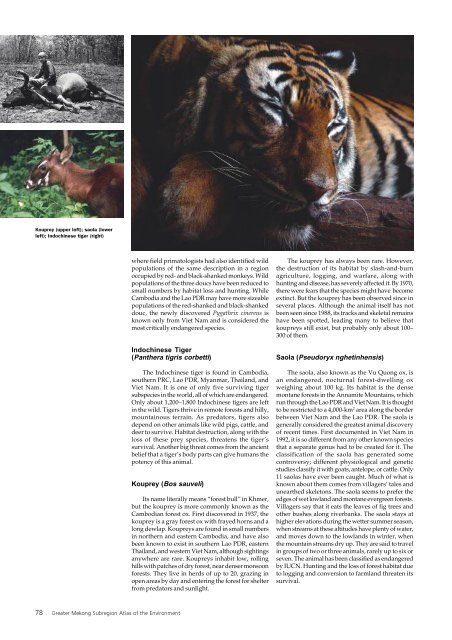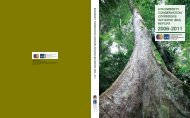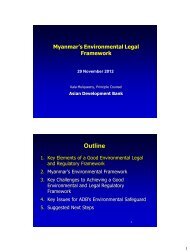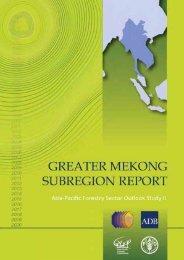Kouprey (upper left); saola (lowerleft); Indochinese tiger (right)where field primatologists had also identified wildpopulations of the same description in a regionoccupied by red- and black-shanked monkeys. Wildpopulations of the three doucs have been reduced tosmall numbers by habitat loss and hunting. WhileCambodia and the Lao PDR may have more sizeablepopulations of the red-shanked and black-shankeddouc, the newly discovered Pygathrix cinereus isknown only from Viet Nam and is considered themost critically endangered species.Indochinese Tiger(Panthera tigris corbetti)The Indochinese tiger is found in Cambodia,southern PRC, Lao PDR, Myanmar, Thailand, andViet Nam. It is one of only five surviving tigersubspecies in the world, all of which are endangered.Only about 1,200–1,800 Indochinese tigers are leftin the wild. Tigers thrive in remote forests and hilly,mountainous terrain. As predators, tigers alsodepend on other animals like wild pigs, cattle, anddeer to survive. Habitat destruction, along with theloss of these prey species, threatens the tiger’ssurvival. Another big threat comes from the ancientbelief that a tiger’s body parts can give humans thepotency of this animal.Kouprey (Bos sauveli)Its name literally means “forest bull” in Khmer,but the kouprey is more commonly known as theCambodian forest ox. First discovered in 1937, thekouprey is a gray forest ox with frayed horns and along dewlap. Koupreys are found in small numbersin northern and eastern Cambodia, and have alsobeen known to exist in southern Lao PDR, easternThailand, and western Viet Nam, although sightingsanywhere are rare. Koupreys inhabit low, rollinghills with patches of dry forest, near denser monsoonforests. They live in herds of up to 20, grazing inopen areas by day and entering the forest for shelterfrom predators and sunlight.The kouprey has always been rare. However,the destruction of its habitat by slash-and-burnagriculture, logging, and warfare, along withhunting and disease, has severely affected it. By 1970,there were fears that the species might have becomeextinct. But the kouprey has been observed since inseveral places. Although the animal itself has notbeen seen since 1988, its tracks and skeletal remainshave been spotted, leading many to believe thatkoupreys still exist, but probably only about 100–300 of them.Saola (Pseudoryx nghetinhensis)The saola, also known as the Vu Quong ox, isan endangered, nocturnal forest-dwelling oxweighing about 100 kg. Its habitat is the densemontane forests in the Annamite Mountains, whichrun through the Lao PDR and Viet Nam. It is thoughtto be restricted to a 4,000-km 2 area along the borderbetween Viet Nam and the Lao PDR. The saola isgenerally considered the greatest animal discoveryof recent times. First documented in Viet Nam in1992, it is so different from any other known speciesthat a separate genus had to be created for it. Theclassification of the saola has generated somecontroversy; different physiological and geneticstudies classify it with goats, antelope, or cattle. Only11 saolas have ever been caught. Much of what isknown about them comes from villagers’ tales andunearthed skeletons. The saola seems to prefer theedges of wet lowland and montane evergreen forests.Villagers say that it eats the leaves of fig trees andother bushes along riverbanks. The saola stays athigher elevations during the wetter summer season,when streams at these altitudes have plenty of water,and moves down to the lowlands in winter, whenthe mountain streams dry up. They are said to travelin groups of two or three animals, rarely up to six orseven. The animal has been classified as endangeredby IUCN. Hunting and the loss of forest habitat dueto logging and conversion to farmland threaten itssurvival.78 Greater Mekong Subregion Atlas of the Environment
Siamese Crocodile(Crocodylus siamensis)The Siamese crocodile, also known as the softbellycrocodile, is an endangered species found inCambodia, Lao PDR, Thailand, and Viet Nam. Itprefers to move in groups in slow-moving areas offreshwater, feeding on fish, amphibians, reptiles,birds, small mammals, and carrion. It grows to about3 m. The Siamese crocodile is not considereddangerous to humans, although it has beenmistaken for its far more threatening cousin, thesaltwater crocodile, which is larger and has anarrower snout. The Siamese crocodile has all butdisappeared from many countries in the subregion,although a new population has been discovered inthe Cardamom Mountains. Expectations for itssurvival are poor because it is under significantthreat from poaching and habitat destruction.Fish of the Major River SystemsAbout 1,200 species of fish have been identifiedin the Mekong River system, and the number isexpected to increase as more field studies are doneand the system of classification improves. Thediscovery of new species is especially likely in themountain tributaries of the Lao PDR and YunnanProvince, PRC, where little or no research has beendone. Only the Amazon River system of SouthAmerica has greater fish diversity—about 2,000 fishspecies are found in a river basin roughly nine timesthe size of the Mekong. Many fish species found inthe Mekong are also found in other rivers of thesubregion. The Ayeyarwady, Thanlwin, and Redrivers, however, have endemic fish species not foundin the Mekong. In fact, the Ayeyarwady River is morelike the Ganges River in its fish species composition.Yunnan Province, PRC, through which all four riversrun, probably has the highest fish diversity of anyregion in the PRC.Several fish species in the subregion’s rivers arealready endangered and, if protective measures arenot taken soon, many more could becomeendangered. Perhaps the most famous endangeredfish are the giant Mekong catfish (Pangasianodongigas) and the giant barb (Catlocarpio siamensis), bothof which can grow up to 3 m long. The giant Mekongcatfish is an important species endemic to theMekong River system. One of the largest freshwaterfish in the world, it grows up to 3 m long and canweigh more than 300 kg. The catfish migrate alongthe rivers to spawn in lakes and tributaries. Thespecies has recently gained recognition because ofthe increasing threat posed to it by humans.Although listed as endangered, the fish are stillcaught and sold for meat in Cambodia, Lao PDR,and Thailand. Because of its size, it is increasinglysought after by sport fishers.The giant catfish and barb qualify for protectionunder the Convention on Biological Diversity (CBD)and the Convention on the Conservation ofMigratory Species of Wild Animals (CMS). While allsix countries represented in the subregion havesigned the CBD, Cambodia, Lao PDR, and Thailandhave yet to ratify it, and none of the six have signedthe CMS.Another famous endangered “fish” in thesubregion is the Irrawaddy or Mekong Riverdolphin (Orcaella brevirostris), whose numbers havefallen drastically over the past 3 decades. TheIrrawaddy dolphin prefers to live near the coast andat the mouth of rivers. It also lives upstream in sometropical rivers. In Myanmar, Irrawaddy dolphinshave been reported at Bhamo, 2,300 km upstreamfrom the mouth of the Ayeyarwady River. Freshwaterpopulations are also found in the Mekong and SeKong. A few years ago, Irrawaddy dolphins were arelatively common sight in rivers and waterways ofthe Lower Mekong and in Tonle Sap Lake. Little isknown about the dolphins, which grow up to 2.8 mlong and can weigh as much 150 kg. A recent surveydiscovered a small population of 80 dolphins livingin the stretch of the Mekong River from Cambodia’snortheastern Kratie Province to the far northernborder with the Lao PDR. These dolphins and theirprey are seriously threatened by entanglement in gillnets, blast fishing, and the potential barrier effectsand habitat degradation from planned dams.Although fishing, hunting, and increased river traffichave wreaked havoc on the dolphin’s habitat, insome areas dolphins are considered sacred. And theyare said to have a special relationship with fisherson the Ayeyarwady and Mekong rivers, helpingfishers drive fish into their nets.Action is being taken in some areas to protectcritical fish habitats and, thus, fish production inthe Mekong and other rivers of the subregion. SomeBuddhist temples in Thailand and elsewhereprovide protection to small stretches of river habitator wetlands, to ensure that some fish will surviveeach dry season to spawn and repopulate the river.Over the past decade, several local communities inChampassak Province, Lao PDR have alsoestablished fish protection areas in the MekongRiver, typically around the deep pools where manyfish species seek refuge during the dry season.Ultimately, the future of many fishes in thesubregion’s rivers will depend on regionalcooperation and strong national and local supportto (i) protect the integrity of key fish habitats fromdeforestation, land reclamation, and otherdestructive actions; (ii) maintain water quality byproviding municipal, industrial, and domesticsewage facilities, and by minimizing the use ofchemical pesticides and fertilizers in agriculture;(iii) maintain open migration routes and provideappropriate fish passes at dams, weirs, and otherobstructions to natural water flow and floodpatterns; and (iv) regulate fishing pressure so thatfish stocks remain healthy and productive, andenforce bans on destructive fishing.Giant Mekong catfish (upper);Siamese crocodile (lower)Environment and Natural Resource Use 79
















